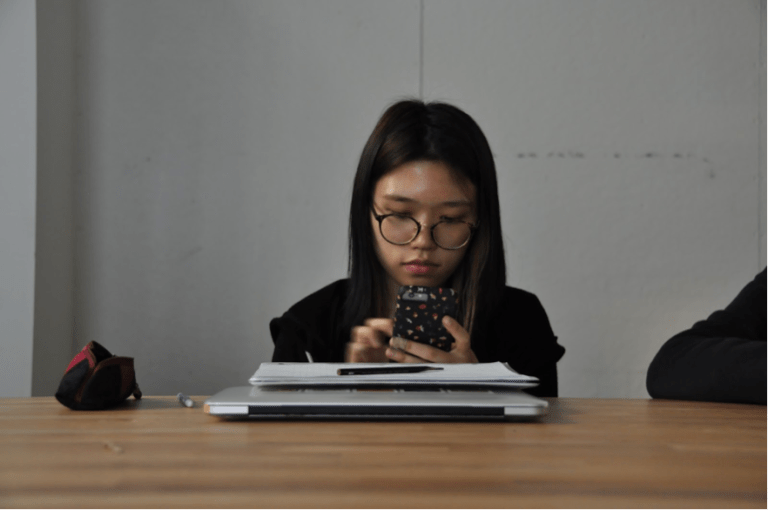In ARTSTUDI 173E: “Cell Phone Photography,” students learn far more than how to perfect their selfies and sunset shots. Through both creating and critically examining digital images, students explore how commonplace technology is transforming art.
The four-unit class, which fulfills the WAYS Creative Expression requirement, has been offered every quarter for the past two years. Instructor Jenny O’Dell, lecturer in Stanford’s Department of Art and Art History, has taught the course since its first year and said that many students enroll expecting a more traditional photography class.
“There’s nothing wrong with wanting to be a good photographer and using your phone to do that,” she said. “But I think you couldn’t really teach a class about that, and it wouldn’t be very interesting.”
Instead, ARTSTUDI 173E focuses on new artistic culture arising from mobile technology. O’Dell described three characteristics of cell phone photography that influence this culture.
“First of all, it’s really malleable,” she said. “The idea that you would immediately want to manipulate your photo and the ease and the speed with which you can move pixels around — that’s all different.”
O’Dell also commented upon the hyper-shareable nature of art on a device primarily meant for communication.
“With a lot of photos, even before you’ve shared them, you’ve kind of shared them in your mind,” O’Dell said. “You’re taking it like an Instagram already.”
Finally, O’Dell said, the massive quantities of cell phone photos uploaded to the Internet encourage a culture of artistic repurposing by creating a virtually infinite stock of material for use. As an artist, O’Dell is mainly interested in what she calls “vernacular imagery” – photography uploaded to sites like Youtube, Yelp and Google Maps, without artistic intentions.
“As opposed to going onto Flickr and finding really high-resolution professionally taken photos, I would be more interested in going on TripAdvisor and looking at the not-so-great photos that a million people have uploaded of the same thing in Yosemite,” she said.
All these qualities of cell phone photography help to emphasize creative ideas over traditional notions of technical skill.
“The only thing to me that really defines an artist now is someone who has a good enough idea,” O’Dell said.
Although O’Dell said she spends more time lecturing in ARTSTUDI 173E than in a typical studio course, she also explained that students’ learning is very hands-on as they experiment with different apps and online tools.
During last Wednesday’s class, students created stop-motion videos with Vine. They also used simple apps like Facegoo and ImgFlip to generate GIFs in which photos of their faces became progressively more distorted.
These activities supported O’Dell’s lesson about the manipulative nature of photography. All photos are staged in some way, she said, and artists can draw attention to this through manipulation of their own.
“If you give people deliberately staged photos, they will learn to become more skeptical of all photos,” she said.
Current member of the class Augie Fabela ’19 appreciates the course’s emphasis on psychology – people’s thought processes as they view or create art. Paloma Hernandez ’18 took ARTSTUDI 173E last fall quarter expecting straightforward instruction in photography but enjoyed learning more broadly about the discipline and how it is changing.
“Most people think of photography as something that is completely honest,” Hernandez said. “The class helped me be a little more critical of media, and the power of media to affect the way people think about things.”
Hernandez also spoke about her newfound respect for the younger, unconventional art forms driven by technology.
“The class taught me to appreciate teen culture and meme culture and Internet culture, because it’s definitely a valid form of expression,” Hernandez said. “People don’t take that seriously, and they should.”
Just as technology is changing art, for O’Dell it is changing her art classes. With topics as contemporary and ever-changing as social media or Internet culture, the teacher is not always the expert.
“If you’re going to be teaching something that’s so skewed toward a younger generation, you really need to rely on them as contributors to the class and fellow experimenters – almost like a research group,” she said.
For example, O’Dell has her students share images and links they think are relevant to the course readings. This helps her tap into the class’s collective knowledge: often, she said, the references that students choose are new to her.
“I’m not going to sit here and tell them about the Internet,” she added. “That’s not going to work.”
Contact Hannah Knowles at hknowles ‘at’ stanford.edu.
